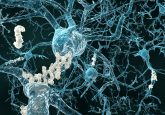New blood test could predict Parkinson’s 7 years before symptom onset

Researchers have used AI to develop a biomarker blood test that can help diagnose Parkinson’s, and also predict the likelihood of its development.
As Parkinson’s disease (PD) is the world’s fastest-growing neurodegenerative disorder, with the prevalence doubling in the past 25 years, there is a desperate need for new treatments and methods for diagnosis. Now, researchers from University College London (UCL; UK) and University Medical Center Goettingen (Germany) have developed a blood test that incorporates AI to predict PD up to 7 years before the onset of symptoms.
PD is characterized by a build-up of the protein alpha-synuclein, resulting in the death of dopamine-releasing neurons in the substantia nigra, which controls movement. The disease is only diagnosed after symptoms appear when many neurons are already impaired. Although there is currently no cure or disease-modifying treatment for PD, researchers believe that early prediction and diagnosis would be valuable for finding treatments that could protect dopamine-producing neurons, and therefore slow or stop PD developing.
“As new therapies become available to treat Parkinson’s, we need to diagnose patients before they have developed the symptoms. We cannot regrow our brain cells and therefore we need to protect those that we have,” commented senior author Kevin Mills (UCL).
To address this, the researchers combined a machine learning tool with mass spectrometry-based proteomic phenotyping to analyze blood samples from individuals with PD and healthy controls and identified a panel of eight blood biomarkers for early PD. Using the panel, they were able to differentiate between PD and healthy controls with 100% accuracy.
 New ultrasensitive screens for Parkinson’s disease
New ultrasensitive screens for Parkinson’s disease
Here David Walt reveals a new alpha-synuclein assay approach that could fast track the diagnosis of Parkinson’s disease and allow researchers to catch the condition at an earlier stage when more can be done to delay its progression. He also reveals his ongoing work with extracellular vesicles and their diagnostic potential for neurodegenerative diseases.
The team then used the test to see if they could predict the likelihood of an individual developing PD. They did this by analyzing blood samples from 72 people with rapid eye movement behavior disorder (iRBD), a sleep disorder in which people physically act out vivid and often unpleasant dreams. Around 75–80% of people with iRBD go on to develop a brain disorder caused by the build-up of alpha-synuclein, such as PD.
The test found that 79% of the people with iRBD had the same biomarker profile as someone with PD, predicting that they would go on to develop PD. Over the next 10 years, the study monitored these individuals and found that 16 of them indeed went on to develop PD, confirming the predictions. Remarkably, the test was able to predict the onset of PD up to 7 years before any symptoms appeared. The researchers are continuing to monitor those predicted to develop PD in order to further validate the test’s accuracy.
Going forward, the team is going to further examine the test’s accuracy by analyzing samples from people with genetic mutations that put them at a higher risk of developing PD. The researchers also note that the eight protein biomarkers could be possible targets for treatments.
“We have not only developed a test, but can diagnose the disease based on markers that are directly linked to processes such as inflammation and degradation of non-functional proteins. So these markers represent possible targets for new drug treatments,” commented co-first-author Michael Bartl (University Medical Center Goettingen).



